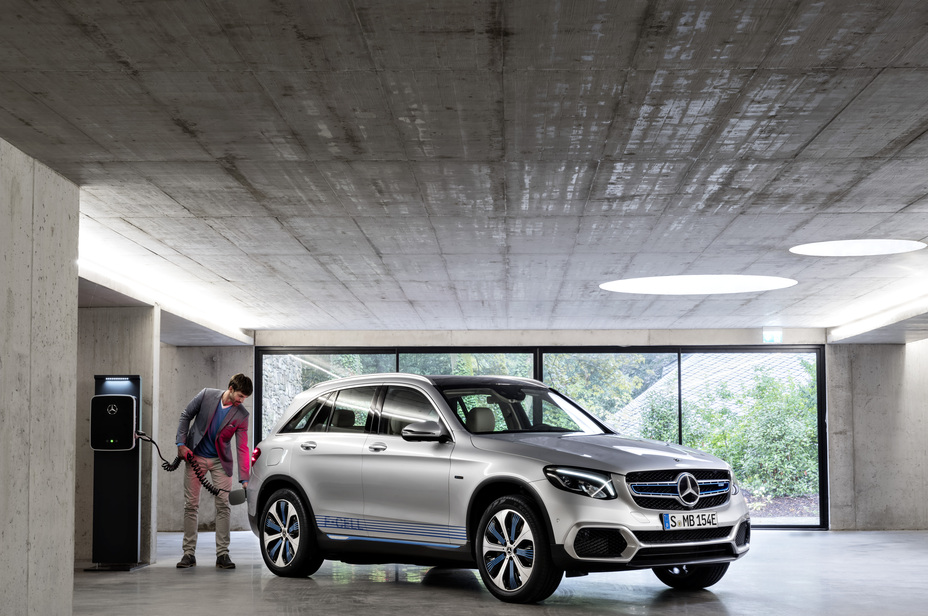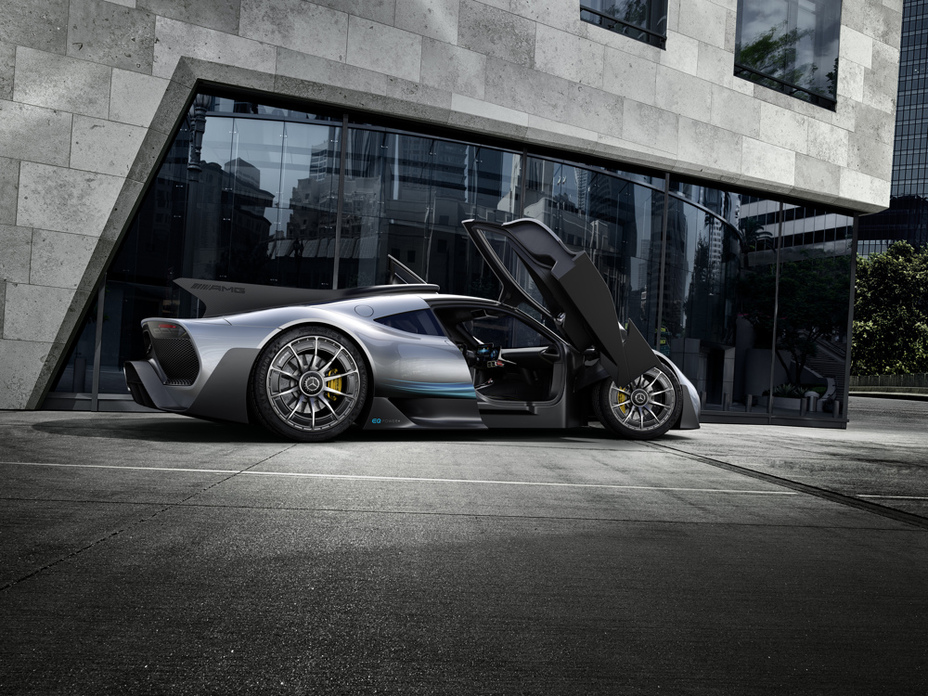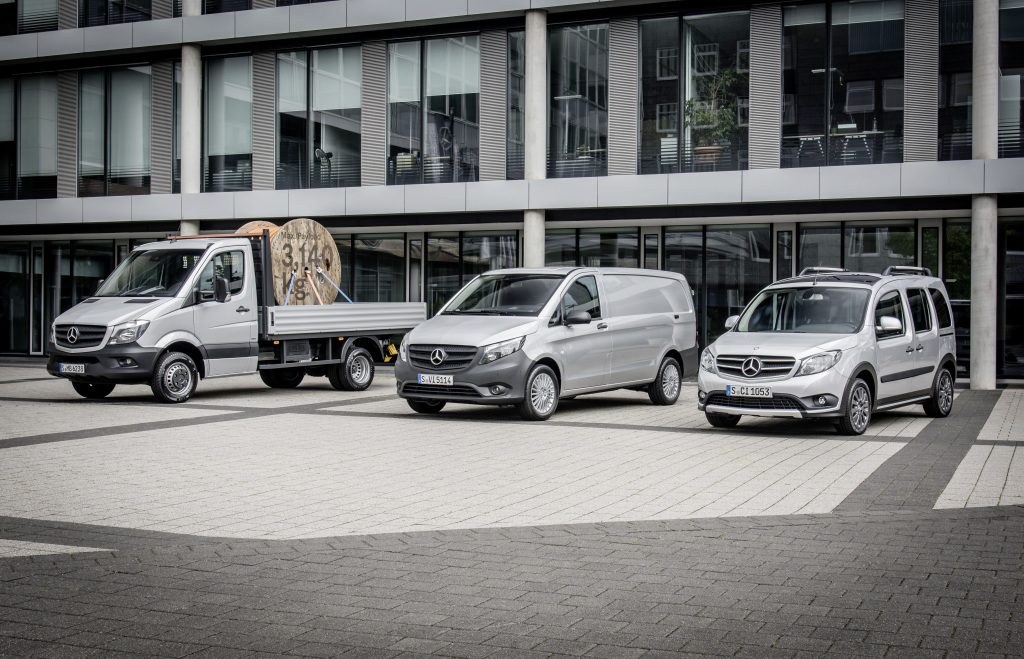At this year’s IAA International Motor Show in Frankfurt, Mercedes-Benz is presenting preproduction models of the new Mercedes-Benz GLC F-CELL as the next milestone on the road to emission-free driving. Under the technology designation EQ Power, the latest electric model (destined for subsequent series production) is set to combine innovative fuel-cell and battery technology in the form of a plug-in hybrid: in addition to hydrogen, the all- electric variant of the popular SUV will also run on electricity. Intelligent interplay between battery and fuel cell, along with short refueling times, will in future make the GLC F-CELL a vehicle of high everyday practicality and also suitable for long-distance motoring. With 4.4 kg of hydrogen on board, the preproduction model produces enough energy for a range of up to 437* km in the NEDC. F-CELL drivers will also benefit from a range of up to 49 km in the NEDC thanks to the large lithium-ion battery. An output of 147 kW guarantees both dynamic performance and locally zero emissions driving pleasure. In unveiling the preproduction vehicles of the Mercedes-Benz GLC F-CELL, Daimler is taking another important step as part of its systematic “CASE” strategy.
Ola Källenius, Member of the Board of Management of Daimler AG, responsible for Group Research & Mercedes-Benz Cars Development, emphasizes: “Our many years of experience with fuel-cell technology pay dividends in the new GLC F- CELL: its long electric range, short refueling times and everyday practicality of an SUV will make it the perfect vehicle. This is made possible by the compact construction of our fuel-cell system. Another genuine world first is the combination with a large additional lithium-ion battery, which can be conveniently charged using plug-in technology.”
Fuel-cell technology is a firm element of Daimler’s powertrain strategy. Under the EQ product brand, the company is pooling its know-how related to intelligent electric mobility while offering a comprehensive e-mobility ecosystem of products, services, technologies and innovations. EQ is therefore a key part of the company’s strategy for the mobility of the future, known at Daimler as “CASE.” The four letters stand for the strategic future pillars of networking (Connected), autonomous driving (Autonomous), flexible use (Shared & Services) and electric drive systems (Electric), which are being systematically further developed and intelligently combined by the company. Between now and 2022, Daimler intends to bring out ten battery-electric vehicles, globally, with the GLC F-CELL representing an important landmark.
Unique: two electric energy sources
The vehicles unveiled at the IAA represent a world first in which a fuel-cell-operated electric car uses a lithium-ion battery as an additional energy source that can be externally charged by means of plug-in technology. Through intelligent interplay, the two energy sources drive the electric motor while offering locally zero emissions driving pleasure. The long range, short refueling time, an output of 197 hp and the latest generation of assistance systems with powertrain-specific features demonstrate, based on the models on show, that the GLC F-CELL will be a family- friendly electric vehicle of high everyday practicality.
For this world first, the Mercedes-Benz engineers cooperated closely with partners from the Daimler competence network to develop a completely new fuel-cell system. Compared with the B-Class F-CELL, which has been on the market since 2010, the overall drive system offers around 40 percent more output. The fuel-cell system is around 30 percent more compact than before, can for the first time be housed entirely in the engine compartment and is installed on the usual mounting points like a conventional engine. Also, the use of platinum in the fuel cell has been reduced by 90 percent. This conserves resources while lowering the system costs – with no compromises in terms of performance.
The lithium-ion battery in the preproduction vehicles on show has a gross capacity of 13.8 kWh and additionally serves as an energy source for the electric motor. For the first time, it can also be charged externally using plug-in technology. An intelligent operating strategy in combination with the fuel-cell/battery system offers maximum efficiency and comfort. Just like the drive motor, the powerful storage battery is space-savingly installed in the rear of the SUV. By means of the 7.2 kW on-board chargers, it can be conveniently charged from a standard household power socket, a wallbox or a public charging station. The charging time is around 1.5 hours if the full capacity is used.
Two carbon-fiber-encased tanks built into the vehicle floor hold around 4.4 kg of hydrogen. Thanks to globally standardized 700 bar tank technology, the supply of hydrogen can be replenished within just three minutes, which is about the same amount of time it takes to refuel a car with an internal combustion engine.
The F-CELL vehicles on show at the IAA are powered by an asynchronous machine with an output of 197 hp and a torque of 258 lb-ft. As the electric drive requires no propeller shaft, this makes room for one of the two hydrogen tanks, while the second tank is installed under the rear seat bench.
Coordinated: operating strategy with unique variety of combinations
Like the GLC Plug-in Hybrid, the fuel-cell variant comes with various operating modes and drive programs. The drive programs of the GLC F-CELL will include ECO, COMFORT and SPORT. ECO is optimized for low consumption. COMFORT is geared not only for comfort, but also provides ideal climate control. SPORT optimizes the hybrid powertrain for sporty performance.
While the drive programs change the behavior of the car and therefore the driving experience, the operating modes influence the interplay between fuel cell and high- voltage battery. The combination of drive programs with operating modes is presented for the first time in this form in a fuel-cell vehicle.
Freedom of choice: four operating modes HYBRID – F-CELL – BATTERY – CHARGE
The innovative plug-in fuel-cell powertrain combines the advantages of both emission-free technologies and, thanks to its intelligent operating strategy, constantly ensures that the use of both energy sources is optimally adapted to the particular operating situation.
In HYBRID operating mode, the vehicle draws power from both energy sources. Power peaks are handled by the battery, while the fuel cell runs in the optimum efficiency range. The intelligent operating strategy means that the characteristics of both energy sources can be ideally exploited.
In F-CELL mode, the state of charge of the high-voltage battery is kept constant by the energy from the fuel cell. Driving almost exclusively on hydrogen is the ideal mode if the intention is to keep the electric range in reserve for certain driving situations.
In BATTERY mode, the GLC F-CELL runs all-electrically and is powered by the high- voltage battery. The fuel-cell system is not in operation. This is the ideal mode for short distances.
In CHARGE mode, charging the high-voltage battery has priority, for example in order to recharge the battery for the maximum overall range prior to refueling with hydrogen. This mode also creates power reserves for uphill or very dynamic driving.
In all operating modes, the system features an energy recovery function, which makes it possible to recover energy during braking or coasting and to store it in the battery.
Safety first: getting there safely
Daimler applies extremely high safety standards in all its vehicles. This is true of both vehicles with a conventional internal combustion engine and also those with an alternative drive. This means that the vehicles comply with all legal standards and regulations. However, the internal safety requirements for Mercedes-Benz vehicles go one step further. The battery and all hydrogen-containing components are governed by particularly stringent safety standards typical of Mercedes. Alongside safety in the event of a crash, all Mercedes-Benz vehicles undergo additional component tests at system level that go far beyond the usual tests. The powertrain components and hydrogen tanks of the F-CELL preproduction vehicles are space-savingly and safely housed in the engine compartment as well as under the floor.
Like all Mercedes-Benz vehicles, the fuel-cell vehicles, too, are exemplary in terms of active and passive safety. With Active Distance Assist DISTRONIC, Lane Tracking Package with Blind Spot Assist and Active Lane Keeping Assist, Parking Package with 360° camera or COMAND with traffic sign recognition, the GLC F-CELL will come with safety and comfort built in as standard.
Self-assured: with the DNA of a genuine Mercedes
The GLC F-CELL models on show at the IAA demonstrate the high expectations on a Mercedes-Benz and all Mercedes-Benz brand values in terms of comfort, sustainability, safety, quality and design. When it comes to loading capacity and occupant comfort, the electric SUV will offer excellent everyday practicality. The only differences will be a minimal step in the luggage compartment, familiar from the GLC Plug-in-Hybrid, and the slightly raised rear seat bench due to the positioning of the hydrogen tanks. Climate comfort in the GLC F-CELL will also be totally on a par with that in a conventional vehicle. Automatic air conditioning with pre-entry climate control as well as heated seats and mirrors are included as standard. At cooler temperatures, the vehicle will make energy-efficient use of the waste heat from the fuel cell in order to optimize the energy balance of the vehicle.
The series-production vehicle, like the preproduction models, will be equipped with coil springs on the front axle and with single-chamber air suspension with integral automatic level control on the rear axle. This means that, even when the vehicle is carrying a load, there is no change in spring travel on the rear axle, which guarantees balanced vibration characteristics with a virtually constant natural frequency of the body, including when the vehicle is loaded.
Unmistakable: Touches in the style of EQ Power
The F-CELL models on display at the IAA embody the current Mercedes-Benz design philosophy of Sensual Purity. The design premises include features that emphasize the special status in general and within the GLC family in particular. These design premises are the formal on-road attributes and the technical modifications to the exterior and interior as well as the control and display concept.
Blue touches on the radiator grille and light-alloy wheels, side skirts and rear bumper on the one hand, as well as classy style wraps with F-CELL inscription on the other, provide a clearly visible indication of the fuel-cell drive. Specifically styled bumpers, with an enlarged air inlet at the front, as well as aerodynamically optimized 20-inch wheels are the hallmarks of the vehicles on show at the IAA.
The interior impresses with its high-grade look & feel and flowing forms as a reinterpretation of contemporary luxury. The center console features elegant trim with flowing lines exuding unique exclusivity in a piano-lacquer look or versatile modern wood surfaces.
Precision-styled details and the choice of authentic materials by using open-pore wood as trim and a high proportion of wool and linen for the fabric covers, make for an agreeable ambience while contributing to the classy overall impression of the interior.
The cockpit will be further enhanced by the instrument cluster in the form of a full display with 12.3-inch diagonal. Information from the COMAND system is presented on the 10.25-inch central display. The menus and indicators on the displays are geared to the functionality of the combined fuel-cell/battery powertrain. The new-type design style clearly differentiates the fuel-cell vehicle from the conventional GLC.
New in the GLC F-CELL is the multifunction touchpad with handwriting recognition, which celebrates its world debut at the IAA in the unveiled preproduction vehicles. This newly developed feature allows telematics functions to be controlled by single- or multi-finger gestures (so-called Multitouch). The touchpad thus offers a full- function and innovative input option over and above LINGUATRONIC in combination with COMAND. The touchpad also makes it possible to enter letters, numbers and special characters by means of handwriting. Further control options are offered by Touch Control buttons on the left and right of the steering wheel as well as by voice control.
Timed to perfection: on the road to series production
Daimler is systematically working to prepare for series production of the Mercedes- Benz GLC F-CELL. With the current test fleet, the Mercedes-Benz engineers are taking the final key steps on the road to production start-up. Market-specific sales concepts, including a rental model, are being evaluated at present. Like the conventionally powered GLC, this family-friendly SUV of high everyday practicality will be produced in Bremen.
During development and production of the innovative fuel-cell drive, Daimler is able to call upon its global competence network. The centerpiece of the technology, the fuel-cell stack, was developed in Vancouver, Canada, together with partner Ford in the Automotive Fuel Cell Cooperation (AFCC) joint venture. Production takes place directly nearby at Mercedes-Benz Fuel Cell (MBFC). The entire fuel-cell unit and the hydrogen storage system were developed by the Daimler subsidiary NuCellSys in Kirchheim/Nabern in Baden-Württemberg. The Daimler parent plant in Untertürkheim is responsible for fuel-cell system assembly, also in Nabern. The hydrogen tank system, consisting of carbon-fiber-encased tanks, is produced at Daimler’s Mannheim plant, while the lithium-ion battery comes from the wholly owned Daimler subsidiary ACCUMOTIVE in Kamenz, Saxony.
Infrastructure is key
A nationwide infrastructure is essential for the success of electric mobility.
The spread of both charging stations and hydrogen filling stations is proceeding apace around the world. Whether at home, at work, on the road or when shopping: there are various ways to supply electric vehicles with power. Also when it comes to H2 infrastructure, progress is constantly being made. Together with its partners in the H2 Mobility joint venture, Daimler has already drawn up a concrete action plan. The network of H2 filling stations is scheduled to reach 100 by the end of next year. By 2023, there will be a network of up to 400 hydrogen filling stations. Similar infrastructure projects are being promoted in Europe, the USA and Japan.
Systematic approach: Daimler opts for electric mobility with fuel cell
It all began back in the 1980s, when Daimler researchers turned their attention to cold combustion. In 1994, Mercedes-Benz unveiled the first fuel-cell vehicle to the global public – the NECAR 1. Many further vehicles followed, including the A-Class F-CELL fleet. In 2011, special attention focused on the F-CELL World Drive, the first round-the-world journey in fuel-cell vehicles. In 2015, the F 015 Luxury in Motion concept car presented an F-CELL plug-in hybrid drive system, designed for 1,100 kilometers of zero emissions motoring. To date, fuel-cell vehicles from Mercedes- Benz, including the B-Class F-CELL and the Citaro FuelCELL Hybrid urban bus, have together covered over eighteen million kilometers, thereby demonstrating the maturity of the powertrain concept. The next technological advance is now imminent: the GLC F-CELL.
The Mercedes-Benz GLC F-CELL will celebrate its World Premiere at the 2017 Frankfurt International Auto Show in September, and will go on sale in the U.S. by the end of 2019.
courtesy: www.media.mbusa.com

















